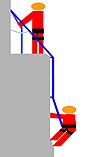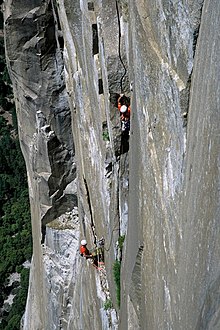| Part of a series on |
| Climbing |
|---|
 |
| Lists |
| Types of rock climbing |
| Types of mountaineering |
| Other types |
| Key actions |
| Key terms |
Multi-pitch climbing is a type of climbing that typically takes place on routes that are more than a single rope length (circa 50 to 70 metres) in height (or distance), and thus where the lead climber cannot complete the climb as a single pitch. Where the number of pitches exceeds 6–10 (300–500 metres), it can become big wall climbing, or where the pitches are in a mixed rock and ice mountain environment, it can become alpine climbing. Multi-pitch rock climbs can come in traditional, sport, and aid formats. Some have free soloed multi-pitch routes.
Multi-pitch climbing is more complex and riskier than single-pitch climbing as the climbers will remain exposed on the route (e.g. a rock climbing route, an ice climbing, or a mixed climbing route) for longer, and it will often involve the use of hanging belays, long abseils, and the creation of belay anchors. Rescues from multi-pitch climbs are far more serious, and climbers will use additional protection to avoid this. Multi-pitch climbing requires greater communication between climbers; advanced climbers can use the riskier—but faster— simul climbing.
|
See also: Lead climbing § Multi-pitch leading |

Multi-pitch lead climbing involves ascending climbing routes that cannot be completed in a single pitch (which is typically a rope-length), usually due to their height but also due to routes that move in unusual directions (e.g. routes with a lot of traversing). Multi-pitch routes are most commonly traditional climbing routes (i.e. the leader inserts the climbing protection as they ascend), but there are also multi-pitch sport climbing routes (i.e. the climbing protection is pre-bolted into the route, or at least where important belay anchors are pre-bolted such as on El Capitan in Yosemite).[1][2]
Multi-pitch climbs are usually done in teams of pairs, and the position of leader can alternate between pitches or after a group of pitches (called "block leading") as long as both climbers have the skill and competence to lead on the route. Alternatively, one climber can lead all of the pitches while the other climber constantly belays them, and is then belayed themselves from the top by the lead climber on each pitch (see image left). Where both climbers are very comfortable on the terrain and want to move quickly, they can use simul climbing, although this is a more complex and riskier technique.
In addition to climbing in pairs, multi-pitch climbs can be done as solo climbs, either as free solo climbing (i.e. no protection used), or as rope solo climbing (i.e. a self-belying system used).[1][2]
The boundary between multi-pitch climbing and big wall climbing or alpine climbing is not defined. Generally, multi-pitch routes that are at least 6–10 pitches or 300-500 metres in length, and mostly require hanging belays (i.e. due to the sheer nature of the route) are considered "big wall routes". Long multi-pitch climbs on mountains whose route is not continually on a sheer "big wall" face, are sometimes referred to as alpine rock climbing. Ice climbing and mixed climbing can also be done as multi-pitch climbing, or as part of an alpine climbing route.[1][2]
|
See also: Rock-climbing equipment |

Multi-pitch climbing requires all the equipment used in leading a single-pitch sport, traditional or ice climbing route, but with a few specific additions:[1][4]

While many of the techniques of single-pitch lead climbing are common to multi-pitch climbing, there are specific techniques that are important to be able to execute well to safely ascend a multi-pitch climbing route:[1][4]
In October 2022, the first competition climbing event in a multi-pitch format was hosted on an artificial climbing wall built on the Verzasca Dam in Switzerland as the 'Red Bull Dual Ascent'. Teams of climbing pairs faced off in head-to-head contests on identical side-by-side 6-pitch 180-metre (590 ft) routes, with the winning team finishing the route in the fastest time. Unlimited falls were allowed as long as the lead climber returned to the base of the pitch (or penalty points were accepted instead). The first event was won by Alberto Ginés López and Luka Potočar.[14] The October 2023 event was held in a mixed team format, with Jernej Kruder and his sister Julija Kruder taking first prize.[15][16]

Multi-pitch climbing routes are generally graded in the same way as their equivalent single-pitch sport route grading, traditional route grading, or ice route grading routes. Each pitch on a multi-pitch route will be separately graded so that, for example, a 3-pitch multi-sport climbing route might be graded as French sport: 7c, 7b, 8a; or a 5-pitch multi-traditional climbing route might be graded as American YDS: 5.10a, 5.10b, 5.10a, 5.11c, 5.9. Harder or easier options on individual pitches will also be highlighted and separately graded, so that, for example, a pitch might be graded as French sport: 7c "avoidable" or "max" (you don't have to do the 7c part) / 7a "obligatory" or "obj" (you will have to do at least 7a graded climbing).[18]
Sometimes an "overall" grade is quoted for a multi-pitch route (in addition to the grades of individual pitches), however, this is usually the grade of the hardest pitch on the route (e.g. see Yeah Man image opposite).[18]
In common with big wall grading, where there are very difficult sections of individual pitches that are well above the general level of difficulty of the overall route (i.e. a common feature of bigger walls as it is harder to find big routes of a consistent difficulty level), an aid climbing option might be highlighted, which will have an attached aid climbing grade, for example, an individual pitch on a multi-traditional climbing route might be graded as: 5.10a (with no aid) or 5.7 A2 (with aid), and the type of aid needed also explained.[18]
A number of notable films have been made focused on multi-pitch (and big wall climbing) including:[19]